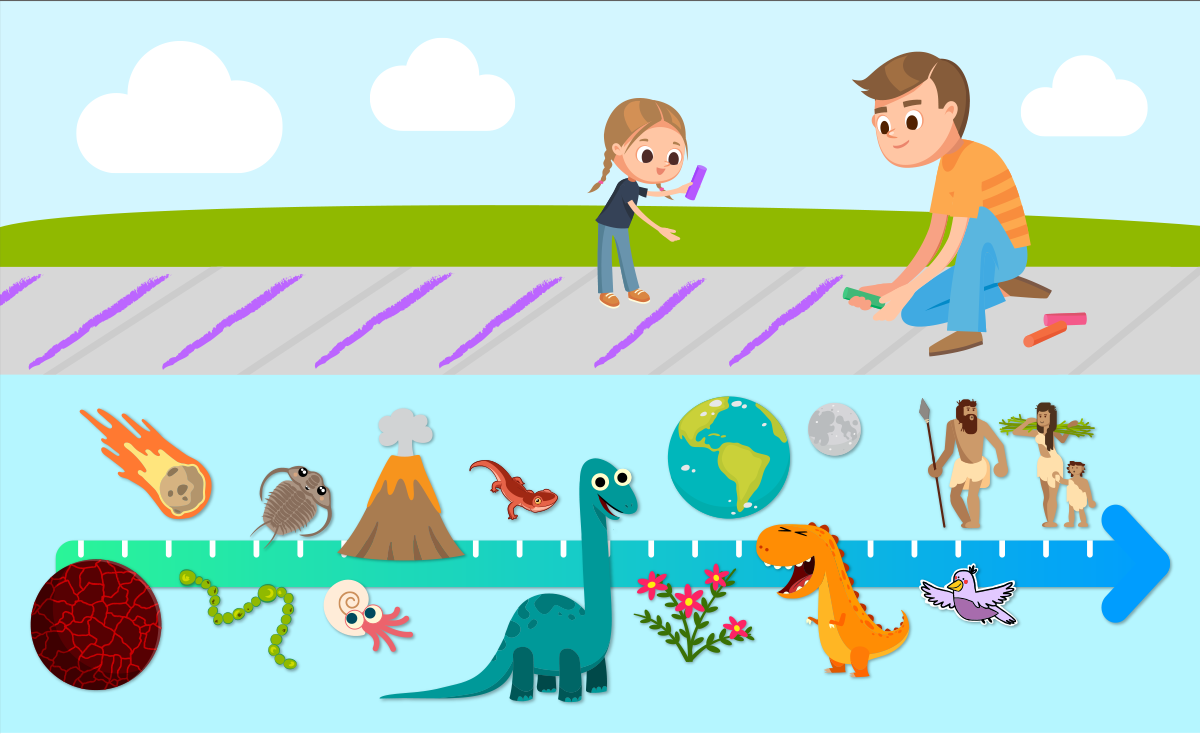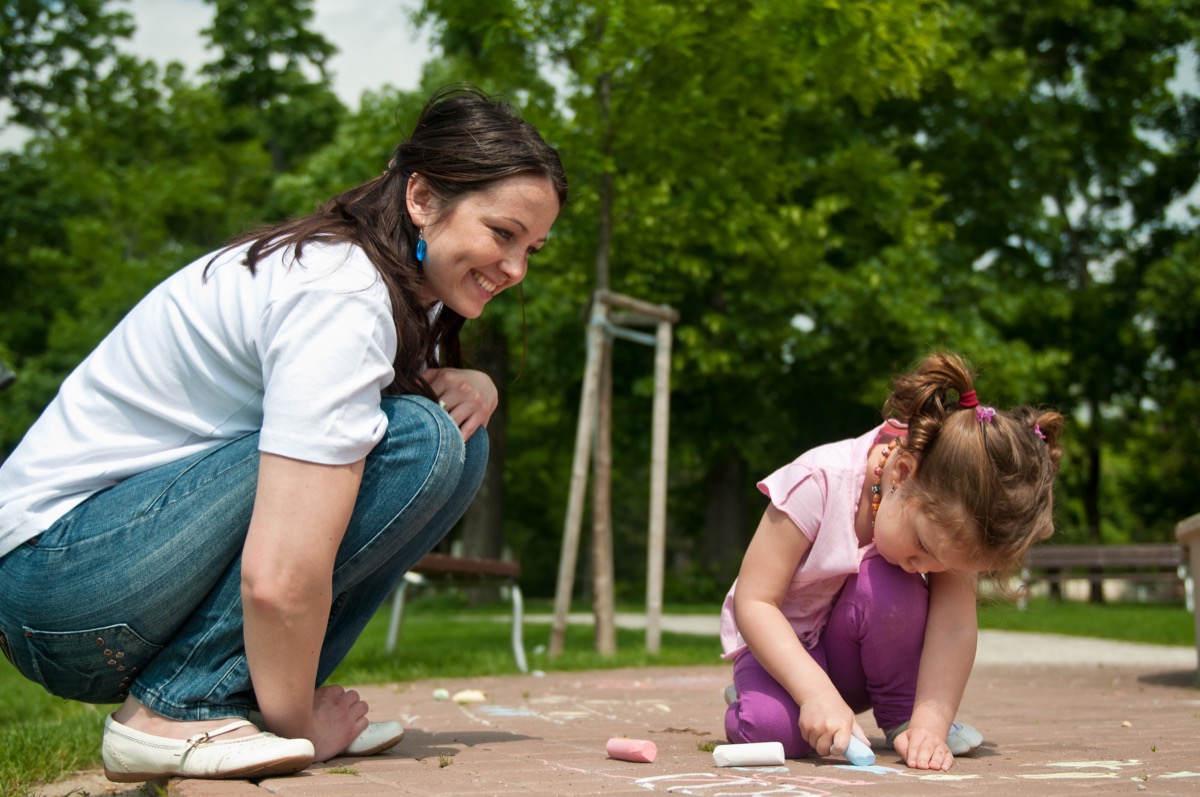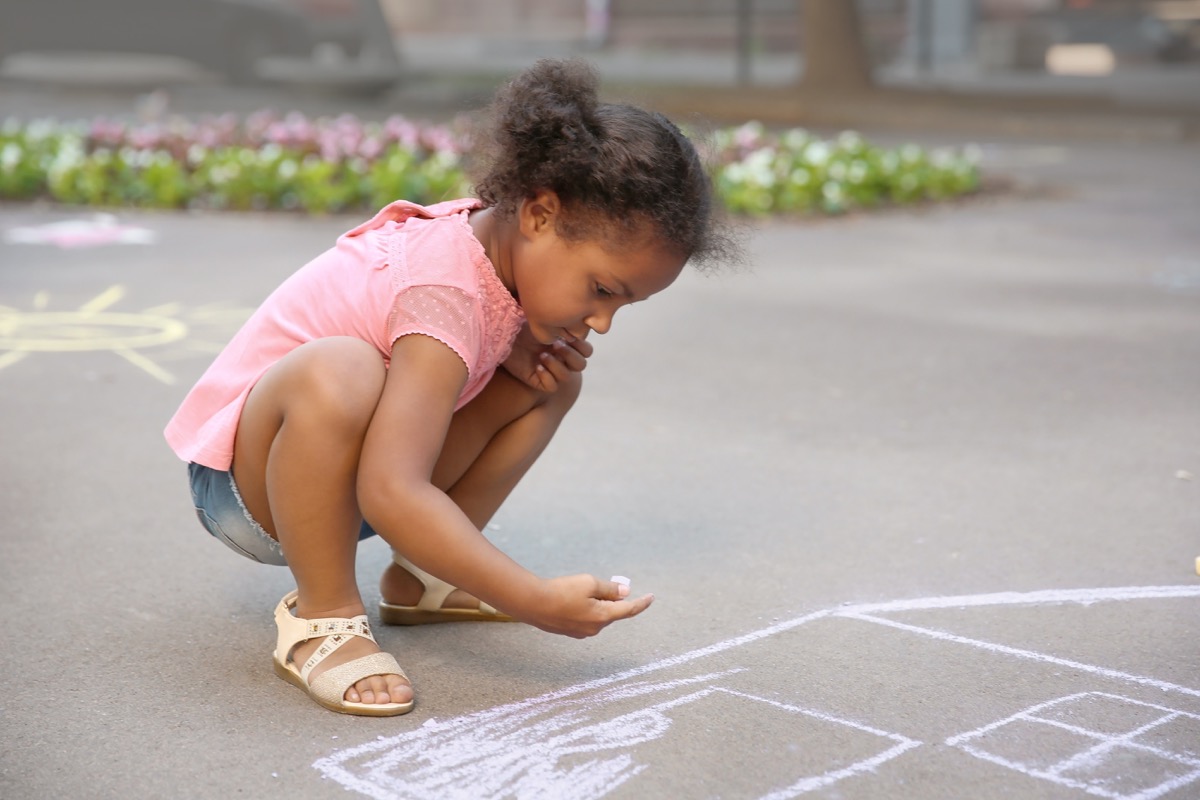
By studying rocks, scientists have figured out how long the Earth has been around. And the answer is: a long, long time.
The earth is four billion, five hundred and forty million years old, and in that time, it’s been through a lot of changes. By contrast, people have only been around for two or three million years, a tiny portion of the Earth’s vast history.
Numbers this big are hard to imagine. So here’s an activity that will help.
You need:
- Sidewalk chalk
- A long sidewalk (You’ll need about 760 feet, so probably two city blocks. Do it in a park if you can, so that you don’t have to cross the street.)
- A grownup helper, if you do need to cross the street (You can also make this an indoor activity by drawing with a pencil on a ten-foot-long strip of paper. Instead of “pace,” substitute “centimetre”.)

In this activity, you will take a walk through time. You’ll see just how old the Earth is, and all the things that have happened over those many years. Every step you take will represent fifteen million years. Fifteen million years is already an unimaginably long time, but as you’ll see, it’s nothing compared to the age of the Earth.
At one end of the sidewalk, use the sidewalk chalk to make a mark on the pavement. This represents the beginning of the Earth’s history, 4.54 billion years ago, when the Earth formed out of clouds of gas and dust. The early Earth was very different from the way it is today. It was incredibly hot, there were no oceans, the air was poisonous, and there was no life.
Starting at this mark, walk seven paces along the sidewalk. Sometime around here, another planet crashed into the Earth, kicking up debris that eventually combined to form the moon.
Walk another three paces. Now the Earth’s surface has cooled down enough that water in the atmosphere turns to liquid and falls as rain. It rains for hundreds of years, forming the oceans.
Walk another twenty paces. This marks the beginning of a long period of asteroids (space rocks) hitting the Earth.
Walk another twenty paces. The long period of asteroid impacts has now ended.
Walk another twenty paces. This is the earliest point in time that everyone agrees there was life on earth. At this time, life only lives in the ocean. These early living things are far too small to see, and they’re made of simple cells, like bacteria are today. But we know they were there, because their growth caused tiny pieces of rock to form into big layered mounds called stromatolites.
Now for the longest walk yet: Walk another seventy paces. One group of living things, the cyanobacteria, has figured out how to get energy from the sun (like plants do today). But this process has a side effect: it produces a large amount of oxygen (the gas that we breathe). This is a huge change in the makeup of Earth’s atmosphere, and it’s the first time that living things had such a dramatic effect on the planet.
Walk another three paces. All that extra oxygen has now caused an extremely long ice age to begin: in fact, it’s possible that the entire Earth becomes covered in ice during this period.
Walk another twenty paces. The ice age has now ended.
Walk another twenty paces. Sometime around here, the first complex cells appear – the kind that plants and animals are made of.
Walk another sixteen paces. Sometime around here, these complex cells group together to form multicellular organisms – living things made of more than one cell. Notice that all life was single-celled for a long, long time. Even today, single-celled life is much more diverse than multicellular life. We just notice multicellular life more because it’s bigger – and because it includes us!
Walk another twenty-four paces. Up until this point, living things have made babies by making copies of themselves. But now, some living things have figured out how to make babies by combining their genes with each other. This is what people do: you’re not an exact copy of your mom or your dad; you’re a combination of the two. This is called sexual reproduction, and it makes evolution move faster.
Walk another forty paces. The earliest fossils of animals are from this time – a type of sea creature called sponges. And from this point on, things get action-packed.
Walk another four paces. Now an event occurs called the Cambrian explosion, in which many major groups of invertebrates (animals without backbones) appear at about the same time. These include members of the clam family, the insect family, and the starfish family. A bunch of really weird creatures appear around this time too, like Opabinia, which had five eyes and a long trunk with a claw on the end! (You can use the sidewalk chalk to draw pictures of some of these creatures if you like.)
Walk one more pace. Now the first backboned animals appear: fish without jaws. The first members of a group of insect-like sea creatures called trilobites appear as well. All animals and plants still live only in the oceans; there is no life on land.
Walk another four paces. Now the first land plants begin to appear. At first, they’re all small, like mosses.
Walk another two paces. Now some invertebrates have followed the plants onto land, to eat them. In the sea, the first jawed fish appear.
Walk another two paces. The first true insects and the first sharks appear, and so do a group of squid-like creatures with spiral shells called ammonites.
Walk another two paces. Now some backboned animals have followed the invertebrates onto land, to eat them. They would have looked like big salamanders.
Walk one more pace. Some plants have now evolved to grow from seeds, which have a protective covering.
Walk two more paces. At this point, all the world’s continents have fused together into a single supercontinent, called Pangaea.
Walk one more pace. This is the time of huge forests of trees, teeming with giant millipedes and dragonflies. When these trees fossilized, they became coal, which we still use for energy today. At the same time, the ancestors of reptiles and mammals developed eggs that could be laid on land, so that they no longer had to return to the water like frogs do.
Walk two more paces. This is the time of creatures like Dimetrodon, which looked like a big lizard with a giant sail on its back like a ruffled potato chip. Dimetrodon is often mistaken for a dinosaur, but it’s actually more closely related to you and me! Besides, dinosaurs hadn’t appeared yet.
Walk two more paces. This is the time of the biggest mass extinction in the history of the Earth, which was caused by volcanoes. Lots of groups of animals died out, including the trilobites.
Walk two more paces. The world has recovered from the extinction event, and the first dinosaurs appear.
Walk one more pace. Now the first mammals appear: animals with fur who feed their babies with milk. You’re a mammal!
Walk two more paces. The supercontinent Pangaea is starting to break up.
Walk one more pace. This is the time of giant long-necked dinosaurs, like Brontosaurus and Brachiosaurus. At the same time, a group of small feathered dinosaurs learns how to fly. Today, we call them birds.
Walk two more paces. The first flowers appear.
Walk four more paces. The dinosaurs have continued to dominate through all this time. Now it’s the time of Triceratops and Tyrannosaurus rex.
But walk one more pace and everything has changed. A giant rock has fallen out of the sky, causing another major extinction. All dinosaurs except birds have died, and so have a lot of other creatures, including ammonites. Now that the big dinosaurs are out of the way, mammals are diversifying like never before. And now that ammonites are out of the way, bony fish are diversifying like never before.
Walk one more pace. India has crashed into Asia (I say “crashed”, but it was far too slow to see), pushing up the Himalayan mountains, the tallest mountains on Earth.
Walk one more pace. The climate has gotten cooler and drier. Forests are giving way to grasslands, where herds of hoofed mammals roam.
Walk two more paces, and that takes you to now. (Make a mark with the sidewalk chalk.) So much happened in that last step you took! The first people appeared. The Earth went through another ice age. People learned how to use fire, and spread all over the world, and invented writing and the wheel and the electric nose hair trimmer. In the grand scheme of things, we only just got here. And yet, we’ve already had an enormous influence on the Earth.
Look back. Can you still see the mark you made back at the beginning of the Earth? This is the biggest lesson the rocks have to teach us: The Earth is really, really old, and people have only been around for a tiny part of its history.

Don’t forget to follow us on Twitter, Instagram, Pinterest, and Facebook!
Original content © 2019 Super Simple. Not to be reprinted without express written permission. Terms of Service.

